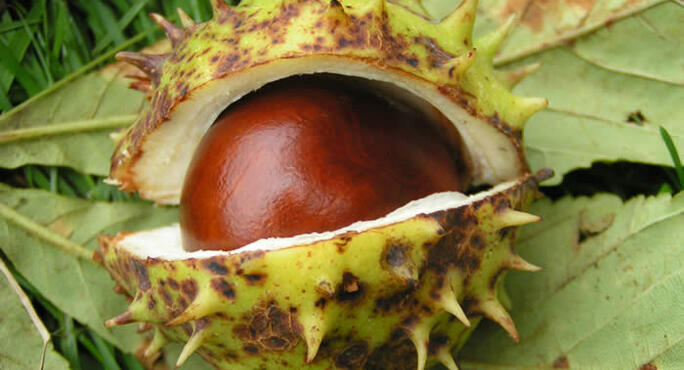Common Name
Botanical Name
Varicose veins are basically veins that bulge. Varicose veins on legs are most common, but hemorrhoids are also varicosities. And while advanced varicose veins may need to be dealt with surgically, there is herbal treatment for mild to moderate cases, in the form of horse chestnut.
Native to the central Balkan peninsula, horse chestnut is a large deciduous tree up to 100 feet tall, with smooth gray bark which becomes scaly with age. The seeds and bark of the tree contain numerous natural compounds of interest to researchers, notably a group known as triterpenoid saponins, and referred to collectively as aescin. Aescin is widely presumed to be the primary beneficial agent in horse chestnut. But chestnut is also a rich source of many additional compounds, including some powerful antioxidants, also known to enhance the health of tissue.
In Germany, horse chestnut has been the subject of focused interest since the 1960s. There research has led to the development horse chestnut seed-derived herbal therapeutics for vein diseases of the legs, including swelling, cramping, inflammation and varicose veins. Today horse chestnut is the third most popular herb in the German market after Ginkgo and St. John’s Wort. The popularity of horse chestnut supplements is testimony to their efficacy.
Medicinal History
In traditional herbal practice, the seeds of horse chestnut, which are known as horse chestnuts or “buckeyes,” have been used as folk remedies for varicose veins and hemorrhoids. In North America, the Iriquois used powdered horse chestnut roots for chest pains. There is remarkably little known history about the traditional use of horse chestnut for therapeutic purposes. Such use presumably began in Europe, where the tree originated.
Habitat & Cultivation
Horse chestnut is planted widely throughout the northern hemisphere as an ornamental. The tree is propagated by seed sown in autumn in sun or in partial shade. The prickly green seed pods are harvested in autumn and are split open to reveal large, shiny seeds.
How It Works
Horse chestnut reduces inflammation and edema, and enhances the tone and fluid balance of veins. Aescin accounts for 3-6% of the seed and is believed to be the primary agent responsible for these activities. Aescin appears to slow down the rate at which fluid leaks from irritated capillaries, improve the elastic strength of veins, and block the release of enzymes which form holes in capillary walls.
Contemporary Uses Approved by Authoritative Bodies
Germany’s Commission E:
- Treatment of chronic veinous insufficiency in the legs, which may include sensations of heaviness, nocturnal cramping, itching and swelling.
- Treatment of varicose veins, edema of the lower limbs and hemorrhoids.
Usage Tips
- The therapeutic dose of horse chestnut is 100 mg of aescin per day, equivalent to 250 – 312 mg of extract 2 times per day. Germany’s Commission E recommends taking horse chestnut extract in a time-release form. Take one dose with morning meal, and one at dinner, with ample fluids.
Product Choosing/Buying Tips
- Look for standardized extracts of horse chestnut in time release form. The most common dose is 300 mg per tablet or capsule, standardized to 50 mg. aescin.


